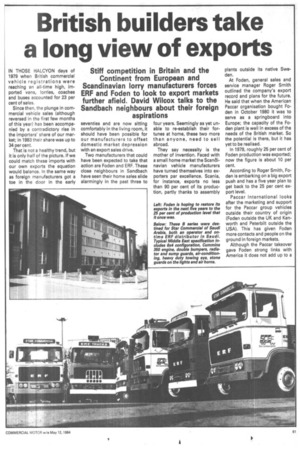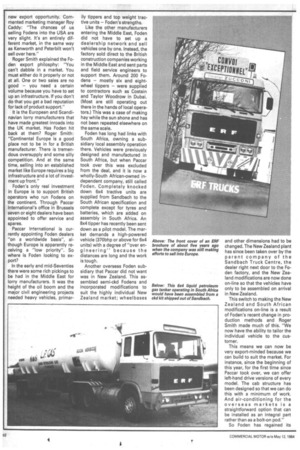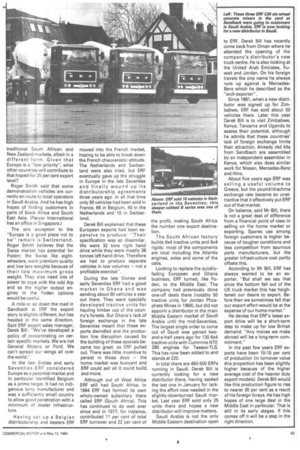British builders take a long view of exports
Page 63

Page 64

Page 65

If you've noticed an error in this article please click here to report it so we can fix it.
IN THOSE HALCYON days of 1979 when British commercial vehicle registrations were reaching an all-time high, imported vans, lorries, coaches and buses accounted for 23 per cent of sales.
Since then, the plunge in commercial vehicle sales (although reversed in the first few months of this year) has been accompanied by a contradictory rise in the importers' share of our market; in 1983 their share was up to 34 per cent.
That is not a healthy trend, but it is only half of the picture. If we could match these imports with our own exports the equation would balance. In the same way as foreign manufacturers got a toe in the door in the early seventies and are now sitting comfortably in the living room, it should have been possible for our manufacturers to offset domestic market depression with an export sales drive.
Two manufacturers that could have been expected to take that action are Foden and ERF. These close neighbours in Sandbach have seen their home sales slide alarmingly in the past three to four years. Seemingly as yet unable to re-establish their fortunes at home, these two more than anyone, need to sell abroad.
They say necessity is the mother of invention. Faced with a small home market the Scanelinavian vehicle manufacturers have turned themselves into exporters par excellence. Scania, for instance, exports no less than 90 per cent of its production, partly thanks to assembly plants outside its native Sweden.
At Foden, general sales and service manager Roger Smith outlined the company's export record and plans for the future. He said that when the American Paccar organisation bought Foden in October 1980 it was to serve as a springboard into Europe; the capacity of the Foden plant is well in excess of the needs of the British market. So the potential is there, but it has yet to be realised.
In 1979, roughly 25 per cent of Foden production was exported; now the figure is about 10 per cent.
According to Roger Smith, Foden is embarking on a big export push and has a five year plan to get back to the 25 per cent export level.
Paccar International looks after the marketing and support for the Paccar group vehicles outside their country of origin (Foden outside the UK and Kenworth and Peterbilt outside the USA). This has given Foden more contacts and people on the ground in foreign markets.
Although the Paccar takeover gave Foden strong links with America it does not add up to a new export opportunity. Commented marketing manager Roy Caddy: "The chances of us selling Fodens into the USA are very slight. It's an entirely different market, in the same way as Kenworth and Pete rbilt won't sell over here."
Roger Smith explained the Foden export philosphy: "You can't dabble in a market. You must either do it properly or not at all. One or two sales are no good — you need a certain volume because you have to set up an infrastructure. If you don't do that you get a bad reputation for lack of product support."
It is the European and Scandinavian lorry manufacturers that have made greatest inroads into the UK market. Has Foden hit back at them? Roger Smith: "Continental Europe is a good place not to be in for a British manufacturer. There is tremendous oversupply and some silly competition. And at the same time, selling into an established market like Europe requires a big infrastructure and a lot of investment up front."
Foden's only real investment in Europe is to support British operators who run Fodens on the continent. Through Paccar International's office in Brussels seven or eight dealers have been appointed to offer service and spares.
Paccar International is currently appointing Foden dealers "on a worldwide basis", although Europe is apparently receiving a "low priority". So where is Foden looking to export?
In the early and mid-Seventies there were some rich pickings to be had in the Middle East for lorry manufacturers. It was the height of the oil boom and the major civil engineering projects needed heavy vehicles, primar ily tippers and top weight tractive units — Foden's strengths.
Like the other manufacturers entering the Middle East, Foden did not have to set up a dealership network and sell vehicles one by one. Instead, the factory sold direct to the British construction companies working in the Middle East and sent parts and field service engineers to support them. Around 200 Fodens — mostly six and eightwheel tippers — were supplied to contractors such as Costain and Taylor Woodrow in Dubai. (Most are still operating out there in the hands of local operators.) This was a case of making hay while the sun shone and has not been repeated elsewhere on the same scale.
Foden has long had links with South Africa, owning a subsidiary local assembly operation there. Vehicles were previously designed and manufactured in South Africa, but when Paccar took over this was excluded from the deal, and it is now a wholly-South African-owned independent company, still called Foden. Completely knocked down 6x4 tractive units are supplied from Sandbach to the South African specification and complete except for tyres and batteries, which are added on assembly in South Africa. An 8x4 tipper has recently been sent down as a pilot model. The market demands a high-powered vehicle (370bhp or above for 6x4 units) with a degree of "over engineering" because the distances are long and the work is tough.
Another overseas Foden subsidiary that Paccar did not want was in New Zealand. This assembled semi-ckd Fodens and incorporated modifications to suit the highly individual New Zealand market; wheelbases and other dimensions had to be changed. The New Zealand plant has since been taken over by the parent company of the Sandbach Truck Centre, the dealer right next door to the Foden factory, and the New Zealand modifications are now done on-line so that the vehicles have only to be assembled on arrival in New Zealand.
This switch to making the New Zealand and South African modifications on-line is a result of Foden's recent change in production methods and Roger Smith made much of this. "We now have the ability to tailor the individual vehicle to the customer.
This means we can now be very export-minded because we can build to suit the market. For instance, since the beginning of this year, for the first time since Paccar took over, we can offer left-hand drive versions of every model. The cab structure has been designed so that we can do this with a minimum of work. And air-conditioning for the overseas markets is a straightforward option that can be installed as an integral part rather than as a bolt-on pod."
So Foden has regained its traditional South African and New Zealand markets, albeit in a different form. Given that Europe is a "low priority", what other countries will contribute to that hoped-for 25 per cent export level?
Roger Smith said that some demonstration vehicles are currently en route to local operators in Saudi Arabia. And he has high hopes of finding customers in parts of black Africa and South East Asia. (Paccar International has an office in Singapore.) The one exception to the "Europe is a good place not to be" remark is Switzerland. Roger Smith believes that the Swiss market has potential for Foden; the Swiss like eightwheelers, want premium quality and low tare weights because of their low maximum gross weight. They also need lots of power to cope with the odd Alp and so the higher output engines in the Foden options would be useful.
A mile or so down the road in Sandbach at ERF the export story is slightly different, but has headed in the same direction. Said ERF export sales manager, Derek Bill: "We've developed a policy of concentrating on certain specific markets. We are not General Motors or Ford. We can't spread our wings all over the world."
In the late Sixties and early Seventies ERF considered Europe as a potential market and in particular identified Belgium as a prime target. It had no indigenous lorry manufacturer and was a sufficiently small country to allow good penetration with a minimum of dealer infrastructure.
Having set up a Belgian distributorship and dealers ERF moved into the French market, hoping to be able to break down the French chauvanistic attitude. The Netherlands and Switzerland were also tried, but ERF eventually gave up the struggle in Europe in the late Seventies and finally wound up its distributorship agreements three years ago. In all that time only 90 vehicles had been sold in France, 66 in Belgium, 40 in the Netherlands and 10 in Switzerland.
Derek Bill explained that these European exports had been expensive to produce: "Their specification was so dissimilar. We were 32 'tons right hand drive while they were mostly 38 tonnes left hand drive. Therefore we had to produce separate vehicles in low volumes — not a profitable exercise".
During the late Sixties and early Seventies ERF had a good market in Ghana and was sending about 60 vehicles a year Out there. They were specially developed tractive units for hauling timber out of the country's forests. But Ghana's lack of foreign exchange in the late Seventies meant that these exports dwindled and the production line disruption caused by the building of these specials became too great, so ERF pulled out. There was little incentive to persist in those days — the home market was buoyant and ERF could sell all it could build, and more.
Although out of West Africa ERF still had South Africa. In 1964 ERF had formed its own wholy-owned subsidiary there called ERF (South Africa). This has continued to do well ever since and in 1977, for instance, contributed 11 per cent of total ERF turnover and 22 per cent of
the profit, making South Africa the number one export destination.
The South African factory builds 6x4 tractive units and 8x4 rigids; most of the components are local including the Atlantis engines, axles and some of the cabs.
Looking to replace the quicklyfading European and Ghana business, ERF turned, like Foden, to the Middle East. The company had previously done one-off deals there (notably 50 tractive units for Jordan Phosphate Mines in 1969), but did not appoint a distributor in the main Middle Eastern market of Saudi Arabia until the mid-Seventies. The largest single order to come out of Saudi was gained twoand-a-half years ago for 130 6x4 tractive units with Cummins NTE 290 engines for Taseco-TLS. This has now been added to and stands at 220.
In total there are 450-500 ERFs running in Saudi. Derek Bill is currently looking for a new distributor there, having sacked the last one in January for lacking the effort now needed in the slightly-downturned Saudi market. Last year ERF sold only 25 units there and hopes a new distributor will improve matters.
Saudi Arabia is not the only Middle Eastern destination open
to ERF. Derek Bill has recently come back from Oman where he attended the opening of the company's distributor's new truck centre. He is also looking at the United Arab Emirates, Kuwait and Jordan. On his foreign travels the one name he always runs up against is MercedesBenz which he described as the "arch exporter".
Since 1981, when a new distributor was signed up for Zimbabwe, ERF has sold about 50 vehicles there. Later. this year Derek Bill is to visit Zimbabwe, Kenya, Tanzania and Uganda to assess their potential, although he admits that these countries' lack of foreign exchange limits their attraction. Already ckd kits from Sandbach are assembled by an independent assembler in Kenya, which also does similar work for Nissan, Mercedes-Benz and Hino.
About five years ago ERF was selling a useful volume to Greece, but the pound/drachma exchange rate became so unattractive that it effectively put ERF out of that market.
On balance, said Mr Bill, there is not a great deal of difference from a financial point of view in selling on the home market or exporting. Spares use among foreign customers is higher because of tougher conditions and less competition from spurious parts manufacturers, but the greater infrastructure cost partly offsets this.
According to Mr Bill, ERF has always wanted to be an exporter. "But shall we say that since the bottom fell out of the UK truck market this has heightened our desire to export. Before then we sometimes felt that our export effort would be at the expense of our home market," He denies that ERF's latest export drive will be a short-term step to make up for low British demand. "Any moves we make abroad will be a long-term commitment."
In the past few years ERF exports have been 10-15 per cent of production (in turnover value this proportion has been slightly higher because of the higher average cost of the heavier duty export models). Derek Bill would like this production figure to rise to nearer 30 per cent as a result of his foreign forays. He has high hopes of one large deal in the Middle East in particular. That is still in its early stages. If this comes off it will be a step in the right direction.












































































































